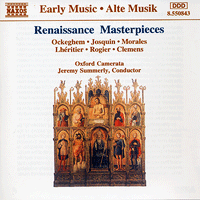It is doubtful whether any of the composers represented on this recording would have had an understanding of the term 'masterpiece' (let alone the term 'Renaissance') when applied to their own music. Similarly, it is unlikely that any of these composers would have considered themselves composers in the sense in which we now understand the word. The Renaissance musician was regarded as more craftsman than artist. Moreover, all of the music recorded here is entirely functional: it was all designed to be used within a living Latin liturgy; it had no other purpose. Beauty is in the eye of the beholder, but it may also be in the mind of the creator, and when composer and performer seem to perceive beauty within the same gesture (although separated by hundreds of years) we may be tempted to describe a work as masterly. In the Nunc dimiltis, for instance, Josquin's anonymous imitator may lack the technical refinement of his mentor, but the product is sincere and moving. Similarly, Thomas Morley's subsequent adaptation of Rogier's Laboravi in gemitu meo evidently reflects a contemporaneous respect for this beautifully-paced motet. And while King Joao IV may have been a discerning musical patron, he was neither a prolific nor great composer; however, Crux fidelis achieves a depth of emotion that was as recognizable to J. S. Bach as it must have been to King Joao's own subjects. Byrd's Laudibus in sanctis is the only concrete example on this recording of the composer giving a particular work his own seal of approval: its position at the head of the 1591 Cantiones sacrae proves that Byrd himself regarded this motet highly, and the fact that it now enjoys unreserved critical acclaim is comforting. |


